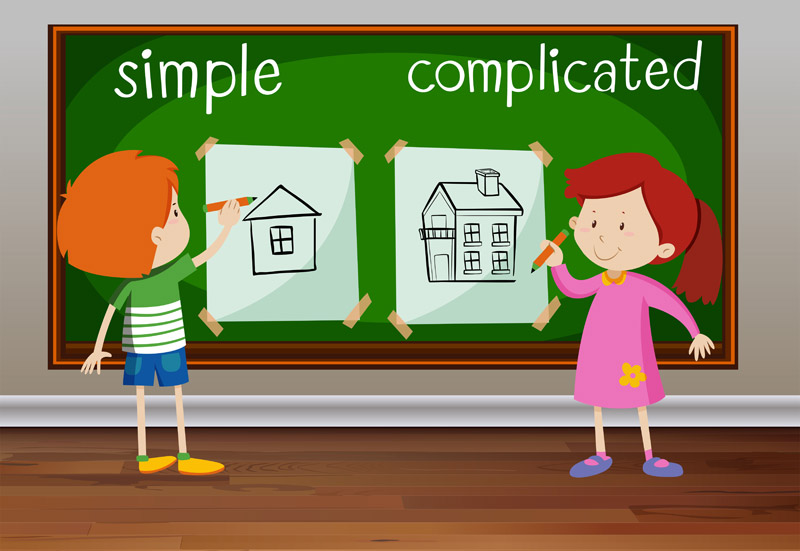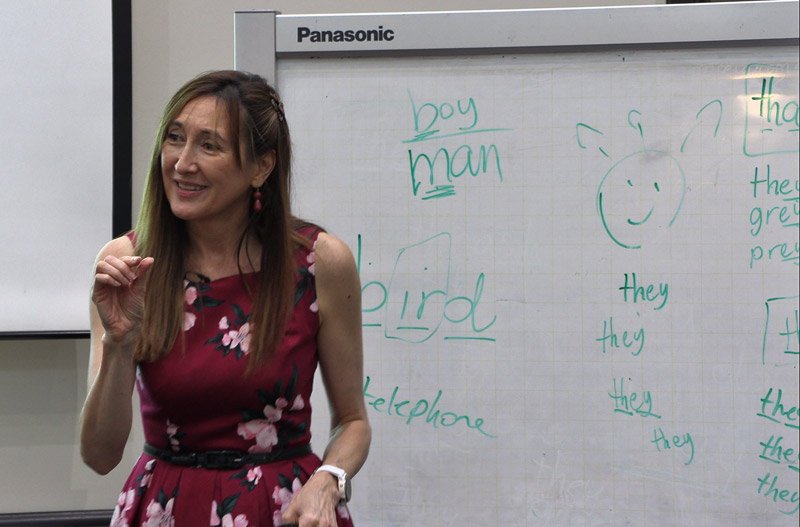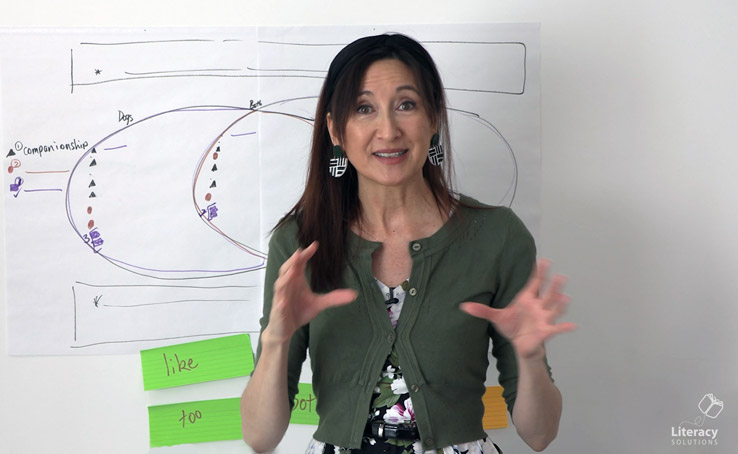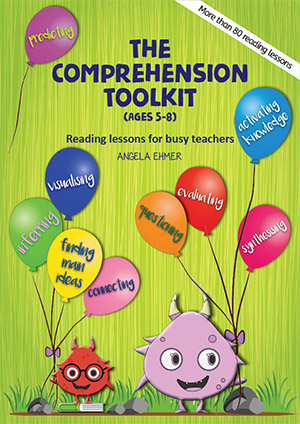Why vocabulary matters to reading and writing success

Research studies identify strong links between the working vocabularies of young children and their subsequent reading achievement levels. There is widespread agreement that vocabulary is one of the keys to reading. Not only is it a valuable predictor of reading success in the early years, but it continues to impact achievement levels well into secondary school. It is critical not only to being able to predict words to solve them more easily, but also correlates strongly to comprehension. Bromley (2007) asserts that understanding word meanings contributes as much as 70-80% to comprehension.
Background experiences
For many, vocabulary is acquired from natural exposure to conversation and interaction, books and media. Frequent exposure to words in context helps to build individual word meaning, as well as to learn what words mean when they are used in phrase units or sentences. For example, the word ‘fence’ has a clearly defined meaning, but when it is accompanied by other words a more meaningful context is created. When placed in a phrase such as ‘on the fence’ it means something quite different to ‘behind the fence’. For many, learning vocabulary in context is all that is required to build an effective working vocabulary for one’s age. However, this is not the case for all. Some students arrive at school with limited vocabularies. It has been well documented that children from lower socio-economic backgrounds know around half the words of those from higher socio-economic upbringings and that a range of other factors contribute to vocabulary knowledge.
In classrooms it is common to observe a range of word knowledge amongst students. These are categorised by Beck, McKeown & Omanson (1987) across four levels:
- The student is unfamiliar with the word.
- The student has heard the word, does not know what it means, but may have a general sense of it having a positive or negative connotation.
- The student controls receptive knowledge of the word and can offer some reasonable suggestions or associations about its meaning.
- The student controls receptive and productive knowledge and not only understands the word but can also use the word.
The final stage highlights the critical link between vocabulary and writing. One can only write using words one knows. A broad vocabulary which includes a high volume of complex words provides greater scope to express ideas than a more limited vocabulary. Vocabulary, therefore, also impacts achievement in writing and speaking.
Explicit teaching

So, what can teachers do about the disparity which currently exists and to ensure we extend the vocabularies of all learners?
Reviews of research into vocabulary suggest implicit instruction is insufficient for students with limited vocabularies and in fact, all students benefit from explicit vocabulary instruction. Beck & McKeown (2002) highlight the importance of ‘rich and robust’ vocabulary instruction for all students, particularly those in the early years. An effective sequence for focused vocabulary instruction (Manyak, Von Guten, Autenrieth, Mastre-O’Farrell, Irvine-McDermott, Baumann & Blachowicz: 2014) includes:
- Highlighting the word in context
- Providing a child-friendly definition
- Giving multiple examples of how the word might be used
- Prompting students to think of the word across other contexts
- Representing the word using images
- Prompting thinking about how the word is used in the context it appeared
- Telling a story without the target word, but which includes a context for the word and having students identify the context
Maintain the profile of target words
Following instructional episodes, it is important to provide frequent and ongoing opportunities to see and use target words in context. Maintaining a high profile and active interest in target vocabulary is essential for increasing uptake and usage. Placing students on high alert for the target words when reading and in classroom interactions, encouraging students to use the word frequently, and apply them in writing and across a range of classroom activities will ensure these words maintain a high profile and are regularly heard and used.
Vocabulary discussion cards
More than 100 vocabulary discussion cards to support early learners and ESL students are available.
Read more:
- Baumann, J. F. & Kameenui, E. J. (1991). Research on vocabulary instruction: Ode to Voltaire. In J. Flood, J.D. Lapp & J.R. Squire (Eds.), Handbook on research on teaching the English language arts (604-632). Macmillan, New York.
- Beck, I., & McKeown, M.G. (2007). Increasing young low-income children’s oral vocabulary repertoires through rich and focused instruction. Elementary School Journal, 107(3), 251–271.
- Beck, I.L., McKeown, M.G. & Kucan, L., (2002). Bringing Words to Life: Robust Vocabulary Instruction. Guildford Press, New York.
- Beck, I.L., McKeown, M.G. & Omanson, C.F. (1987). The Effects of Long-Term Vocabulary Instruction on Reading Comprehension: A Replication. Journal of Literacy Research. 15 (1), 3-18.
- Bromley, K. (2007). Best practices in teaching writing. In L.B. Gambrell, L.M. Morrow & M. Pressley (Eds.), Best practices in literacy instruction. Guildford Press, New York.
- Cunningham, A. E., & Stanovich, K.E. (1997). Early reading acquisition and its relation to reading experience and ability 10 years later. Developmental Psychology, 33(6), 934–945.
- Graves, M., & Slater, W. (1987, April). The development of reading vocabularies in rural disadvantaged students, inner-city disadvantaged students, and middle-class suburban students. Paper presented at the annual meeting of the American Educational Research Association, Washington, DC
- Hart, B., & Risley, T. R. (1995). Meaningful differences in the everyday experience of young American children. Paul H Brookes Publishing.
- Manyak, P.C., Von Gunten, H., Autenrieth, D., Gillis C., Mastre-O’Farrell, J., Irvine-McDermott, E., Baumann, J.F., Blachowicz, C.L.Z. (2014). Four practical principles for enhancing vocabulary instruction. The Reading Teacher, 68(1), 13-23.
- Nagy, W., Herman, P., & Anderson, R. (1985). Learning words from context. Reading Research Quarterly, 20, 233-253.
- Rinaldi,L., Sells, D., & Mclaughlin, T.F.(1997). The effects of reading racetracks on the sight word acquisition and fluency of elementary students. Journal of Behavioral Education, 7(2), 219–233.
- Stahl, S., & Fairbanks, M. (1986). The effects of vocabulary instruction: A model-based meta-analysis. Review of Educational Research, (56),72-110.
- Tomeson, M. & Aarnoutse, C. (1998). Effects of an instructional programme for deriving word meaning. Educational Studies, 24(1), 107–222.
- White, T. G., Graves, M.F., & Slater, W. H. (1990). Growth of reading vocabulary in diverse elementary schools: Decoding and word meaning. Journal of Educational Psychology, 82(2), 281–290.




